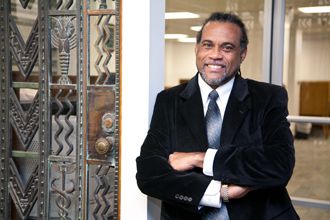Medical Library Director Takes Advocacy Role
The library at the Tulane School of Medicine has been a rich resource for doctors and medical students since the founding of the library in 1934. Named the Rudolph Matas Medical Library in 1937 after a renowned member of the faculty, the library continues to serve the Tulane health sciences community in new and expanded ways. And since early January, the library has been under the leadership of a new director, Neville Prendergast.

Neville Prendergast, new director of the Rudolph Matas Library of the Health Sciences at Tulane, is reaching out to faculty to let them know what the library offers. (Photo by George Long)
“What I'm trying to do, as I've come in new and fresh, is to involve faculty more in what the library does, and to involve the library more in what the faculty does in their research and teaching,” he says. Hailing from Jamaica, Prendergast received a graduate degree in library science from the University of Buffalo and served as assistant librarian of the health sciences libraries at Buffalo, then associate director at Washington University in St. Louis, prior to being named director at Tulane.
The medical library, now the Rudolph Matas Library of the Health Sciences at Tulane, was significantly refurbished in 2008, including a redesign of the main reading room on the second floor of the medical school, resulting in a sleek, modern feel.
“The result is that the students and faculty feel more comfortable using the library,” says Prendergast. “Some shelves were removed, and the books that were on that level are now on the mezzanine level below.”
The library currently has a total of 157,819 volumes. The digital age has shifted the paradigm of what comprises a library, however, and offering up-to-date information is vital for the library's mission.
“We have definitely moved into the business of purchasing electronic books we have quite a big collection,” says Prendergast. “We are doing a little less monograph buying and buying more into e-books. We have access to over 14,000 online journal titles and more than 500 e-book titles.”
To learn what faculty members think about library services, Prendergast asked each department in the medical school to designate a faculty member as a liaison to the library.
“We have a pool of librarians who also are liaisons to those departments,” says Prendergast. “It's a matter of two-way communication. We inform them on what we are interested in doing, and they tell us what they want, and so we have a common ground as to how best to fulfill their needs.”
In addition, Prendergast has been working with the Office of Medical Education to help plan some faculty development programs.
“If they decide the faculty should know about some of our information resources, I can go and give them a presentation on, for instance, our online evidence-based medicine resources.”
Prendergast is planning to work with the school's curriculum planners to integrate the library's wide spectrum of resources with the curriculum on a year-by-year basis. He is also working with the School of Public Health and Tropical Medicine and the Tulane National Primate Research Center to enhance the library's benefits for their students, faculty and researchers.
“Just as libraries now are going out to access remote collections and electronic resources, I am going out of the library to meet and greet faculty in their labs and classrooms,” says Prendergast. “This is to remind them that the library has a role to play in terms of service to this community. If nobody knows we have these excellent resources, they will just sit there and not be used and we don't want that to happen.”
